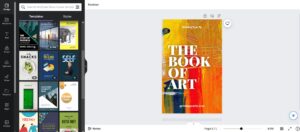
Last updated on March 5th, 2024 at 11:27 am
Booklet printing is more than just putting words and pictures on paper; it is about making your ideas feel natural and easy to hold. How you put together the pages of your booklet matters because it changes how people read and enjoy it. We’re here to show you nine simple but innovative ways to arrange your booklet’s pages. This will help ensure your booklet is lovely, fun, and easy to read.
It’s all about making your booklet something people want to pick up, read, and remember. Let’s jump into how to make your booklet stand out and stick with your audience long after they’ve converted through the last page.
Crafting Booklet Printing with creative layout tips
Mastering page layout is critical to captivating your readers—discover how these nine tips can transform your booklet into a memorable experience.
1. Create an Engaging Cover Page
Think of your booklet’s cover page as its welcoming face. It’s the first thing people see and sets the mood for everything else. Here’s how to nail it.

Visual Appeal
Your cover’s look is super important. Pick colors that grab attention and match what your booklet talks about. Use pictures or designs that draw people in, ensuring they fit your booklet’s message. A clear, bold font will help your title jump off the page and help to make your cover page memorable.
Clear Title and Subtitle
Your title must tell readers what they’re about to dive into quickly. If it’s not all clear from the title, a subtitle can help add more detail. The goal is to be catchy yet straightforward, offering a peek into the booklet’s content.
Eye Catching Graphics
Putting excellent graphics on the cover page makes your booklet even more appealing. These should go well with your booklet, linking the cover to the stories or information. Ensure graphics catch your reader’s attention with exciting photos or unique drawings that show your booklet story.
2. Creating a Smooth Reading
Once you’ve caught your audience’s attention with an eye-catching cover, the real journey of booklet printing beginsᅳguiding them smoothly through your content. Let’s break it down into simple, straightforward steps.
Sequential Organization
Organize your content in a manner that unfolds naturally. Whether your booklet follows a chronological order, thematic progression, or problem-solution format, ensure the sequence is intuitive for the reader.
Clarity in Hierarchy
Create a hierarchy within your content using headings and subheadings. Differentiate main ideas from supporting details, aiding readers in navigating the information effortlessly. This hierarchy adds clarity to your message.
Consistent Formatting
Consistency is critical to maintaining a professional and polished look. Use the same font, color scheme, and layout throughout the booklet. Consistent formatting contributes to visual coherence and reinforces your brand identity.
3. Consistent of Themes and Branding
When we talk about “Consistent Themes and Branding” in the world of booklet printing, we’re diving into the crucial aspect of making your booklet not just a collection of pages but a unified and recognizable representation of your brand or message.
Consistent Themes
Consistent themes mean using the same design elements, colors, and styles throughout your booklet. It’s like giving your booklet a signature look, making it easily recognizable. Imagine your booklet as a story, each page contributes to the same visual tale. This helps in creating a cohesive and harmonious reading experience.
Branding
Branding is about making your booklet a true ambassador of your brand or message. It involves incorporating your logo, tagline, and overall brand identity into the booklet. The goal is for readers to instantly connect the booklet with your brand, creating a lasting impression.
4. Include Eye-Catching Visuals
Visual elements are pivotal in capturing and retaining the reader’s attention. Here’s how to incorporate eye-catching visuals effectively.
High-Quality Images
Opt for high-resolution images that are relevant to your content. Clear, sharp images enhance the overall visual appeal of your booklet. Ensure the photos align with your message and are placed thoughtfully within the layout.
Graphic Elements and Icons
Integrate graphic elements and icons to break up text and add visual interest. Icons can emphasize key points or guide the reader through specific sections. Consistent use of graphics contributes to a visually engaging design.
5. Importance of Creative Page Borders
Adding creative borders to your pages can bring a distinctive and polished look to your booklet. Here’s a breakdown of how to effectively use creative page borders.
Purposeful Framing
Use borders to frame specific sections or content within your booklet. This intentional framing draws attention to key information, making the visual organization of your pages more effective.
Consistent Design Elements
Keep a similar design theme with your borders. Whether you choose a simple line or a detailed pattern, using consistent design elements ties the booklet together, resulting in an overall unified and polished appearance.
Interactive Borders
Consider adding interactive elements within the borders, like small illustrations or icons. These additions create a sense of engagement and help guide the reader’s focus, making the overall layout of your booklet more dynamic.
6. Unique Folding Techniques
Experimenting with folding techniques adds an element of surprise and creativity to your booklet. Here’s how to unique folding methods effectively.
Zigzag Folds
Zigzag folds give your booklet a neat and visually interesting layout. This technique slowly reveals information, almost like telling a story. It works especially well for timelines or step-by-step guides.
Door-like Folds
Door-like folds involve folding the paper like opening doors. This method is perfect for revealing a central piece of important information or creating a dramatic surprise within your booklet.
Personalized Folds for Emphasis
7. Incorporate Ample White Space
Using white space is essential for creating a clean and sophisticated design. Here’s how to effectively incorporate ample white space into your booklet.
Enhancing Readability
White space around text enhances readability by preventing visual clutter. Make sure enough space between lines, paragraphs, and images to allow the reader’s eyes to navigate smoothly through the content.
Creating Balance
Use white space to create a balanced layout. Distribute elements evenly across the page, avoiding overcrowding. A well-balanced design contributes to a harmonious and aesthetically pleasing booklet.
Emphasizing Key Elements
Allow white space to draw attention to important elements. Whether it’s a headline, image, or call-to-action, surrounding key elements with white space ensures they stand out and capture the reader’s focus.
8. Use Varied Font Styles and Sizes
Diversifying your typography adds visual interest and emphasis to different elements within your booklet. Here’s how to effectively use varied font styles and sizes.
Headings with Impact
Opt for bold and distinctive fonts for headings. The goal is to make section titles stand out and grab the reader’s attention. Experiment with different font styles that resonate with the overall theme of your booklet.
Accurate Variation for Subheadings
While maintaining readability, introduce subtle variations in font styles or sizes for subheadings. This helps create a visual hierarchy, guiding the reader through the content and highlighting key sections.
Consistency in Body Text
For the body text, choose a clear and legible font. Maintain consistency in font size and style for optimal readability. A cohesive body text style ensures a smooth reading experience throughout the booklet.
9. The Final Check
Before you send your fantastic creation to the printer, take a good look. Check for spelling mistakes, grammar slip-ups, or any layout issues that might distract your readers.
The Importance of a Final Proofread
Doing a final check before printing is like giving your booklet a last hug before it goes out into the world. It’s your chance to catch any sneaky mistakes that might have slipped through earlier.
Ensuring a Smooth Reading Experience
A final proofread ensures your readers won’t stumble over typos or get confused by awkward sentences. It’s like putting a cherry on your booklet to make it a delightful read.
Conclusion
Achieving a practical and visually appealing booklet layout requires thoughtful planning and creativity. By implementing these nine ideas, you can elevate your booklet printing project, leaving a lasting impression on your readers and effectively conveying your message. Remember, a well-arranged booklet enhances the reading experience and reflects positively on your brand or message.
